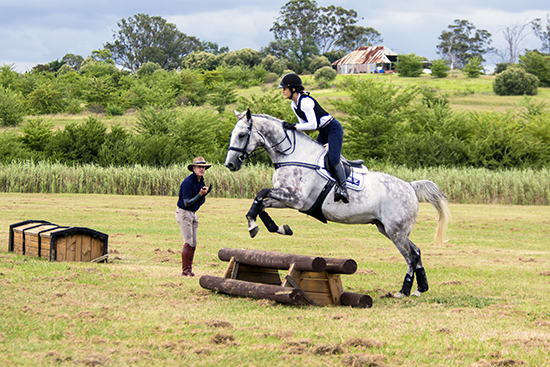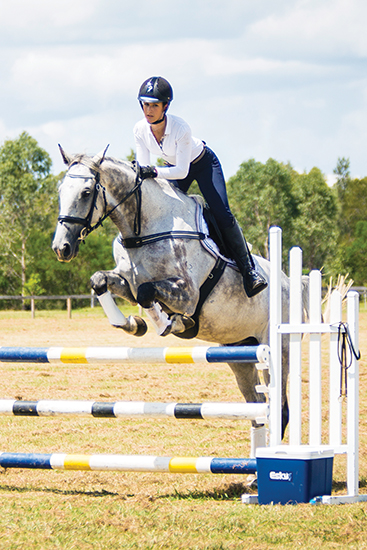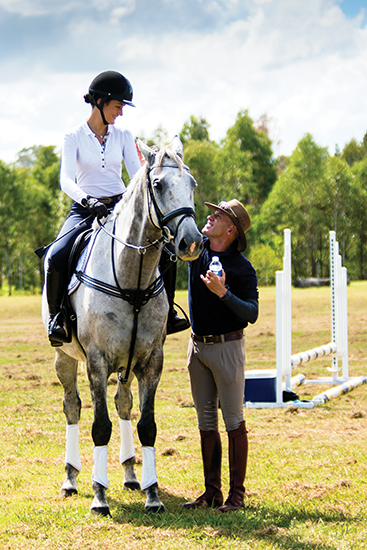 Words by Liz Crosato and Photos by Rebecca Ashton
Words by Liz Crosato and Photos by Rebecca Ashton
I was invited by the Horse Magazine to attend a day at the Andrew Hoy clinic at Camden. I gladly accepted and was really excited but also nervous to be taught by such a prominent figure in the Equestrian world. Hawk and I are competing up to 2** level and have been together for nearly two years. He is my second horse to bring me up the levels and has shown great potential from day one. With continuous support and influence from Tallara Barwick, my instructor, we have been able to see him develop and grow stronger everyday. Hawk is a naturally talented and careful jumper but it has been our flat work that has constantly needed improvement.
A few days before the lesson, Mark Williams, who organised the clinic, sent me some of Andrew Hoy’s DVDs to understand his style of teaching which really helped me to be ready and prepared for the day. As we waited for Andrew to finish up with his previous lesson, I met the other two riders who were in the clinic, Judith Street and Gemma Youl who were just as excited as I was. To start the session Andrew spoke about what he believes are the key factors to a successful partnership between horse and rider. These he refers to as ‘four-by-four’.
The first four describes the things horses naturally do in a paddock; walk, trot, canter and gallop. He expressed how a horse has the natural ability to do these movements without the interference of the rider. This leads onto the second four which describes the rider’s role: 1. Make your horse come back 2. Make the horse move in front of your leg 3. Steer left and 4. Steer right. These four aids should only minimally interfere with the four natural movements of the horse. My interpretation of Andrew’s ‘four-by-four’ idea is the need to not over-complicate riding, as tends to sometimes happen with modern techniques.
Andrew’s idea of not trying to over-complicate the way we ride continued through to our equipment with all of us having a piece of our gear taken off us. Even before we started working our horses we were stripped of martingales, flash nosebands and whips. Andrew checked all of our bits as he believes that in order to effectively communicate with your horse you need a direct rein to the horse’s mouth through a simple bit such as a snaffle, rather than one with a shaft, which acts as a lever and delays the aid given by the hand. He taught us that latest gadgets don’t necessarily fix the problem, but in many cases over-complicate it.
At the beginning of the lesson Andrew encouraged us to ride our horses the way we would ride at home. He proceeded to comment on all our differing positions and methods of working. He is a strong believer in the rider’s position being soft and light, which I found worked really well for me and my horse. Hawk softened up and happily cantered at his own relaxed pace. Andrew expressed constantly, “be soft, don’t interfere, allow your horse to canter.” He wanted us to not be controlling riders, but to allow the horse to think for itself. He also stressed the importance of a rider having a clear understanding of their centre of balance. This meant a comfortable two-point position; not falling back into the saddle, or falling forward onto the horse’s neck. He believes that if the rider is well balanced then the horse will naturally become balanced too. We practised a two-point seat over a pole at walk, trot and canter, alternating our direction of approach. At times this felt awkward, never touching the saddle with the seat, however it allowed the horse to be ‘free’ which was an idea Andrew came back to constantly.
Andrew explained that instructors can only teach technique, but technique is only half of what the rider must comprehend to ride well. A successful rider must also have the natural ability to ‘feel’ the horse and understand what is happening underneath them and follow through with the appropriate aids. An example given, was in a dressage test, if your horse has become tense after a lot of movements, you need to ‘feel’ and understand what’s best to relax your horse. Without ‘feeling’ your aids will not be one hundred percent effective.
As the lesson continued we started do ride individually. Whilst on a circle over a vertical jump, Andrew gave continuous advice to the rider, but also taught the rest of the group and others observing as he believes watching is a major factor in his lessons. From this I really understood how assessing others was just as important as assessing myself. Watching someone else ride and discussing as a group really helped me understand my own flaws and how I can work to improve them.
Andrew voiced throughout the lesson that the rider must be in control of the situation, without being forceful or too soft; the horse needs to accept you. The rider needs to be the leader so that the horse respects you and your aids. During the next exercise, the main focus was the importance of your line to the fence you are jumping. Back to the vertical on the circle, he stressed the idea that we must approach the jump on a correct circle line rather than straighten up before the jump; we needed to trust and ‘feel’ our distance rather than take a wider or sharper turn to correct it. As riders we have a role to ensure the horse is in an appropriate position to successfully and safely jump the fence.
It was emphasised that where you look as a rider is very important. Riders should never take their eyes off their horse’s head as this allows you to comprehend what the horse is thinking. From their ears, eyes, mouth and head as a whole, we should be able to understand what mood they are in. Knowing the horse’s attitude, we can be a productive rider and understand what is best for them. The only time we were allowed to look away was on approach to the jump at which point the front top rail was the focus. You must never be distracted by what is around you as this can be very dangerous for you and your horse.
After working on the rider’s jumping ability the focus was then on how to improve the horse’s jump. Andrew continued to change the ground rail to see which combination made my horse jump to the best of his potential. For Hawk there was a clear improvement when there were two close ground poles which were quite far out from the vertical. Many of us found this concept very useful to see how particular jump combinations affected each horse individually. Andrew thought that the theory could be practiced at home to improve and strengthen the horses’ jumping ability. It was surprising how something so small, in my case the ground rail, could really help the horse.
After a lunch break, it was time for the cross country lesson starting with some houses and boxes around prelim height (95cm). There was a line of around six fences side by side, which we had to do in order, turning left and right each time. While having a weave effect over all the fences Andrew believed that this should be a smooth and freeing exercise, allowing the horse to turn smoothly with an open canter with the horse spotting the fences on its own. Throughout this exercise we were not allowed to sit in the saddle but constantly be in a two-point position as he put it, “Allow the horse to do the work”. Once we all went through the exercise smoothly, and the horses were warmed up, we then moved over to the water jump. As we reached the water Andrew wanted us to walk the horses in and out for a while until they were confident, without the rider having to kick, before trotting and cantering in until the horses were relaxed at these paces as well. As a rider it was nice not having to rush as Andrew believed that you can’t jump your horse into water if he isn’t comfortable to freely canter in himself.
Once all the horses were relaxed we started to jump into the water. Andrew strongly pointed out that the horse shouldn’t change its pace, but jump into the water without hesitation. As a rider you need to be proactive, giving your horse the appropriate line and feeling what your horse is thinking. We slowly moved up to the bigger jumps into water, however Andrew had a particular point he wanted us to remember; he emphasised, “No matter how high the jump is into water you should always ride it the same. Your canter should be good enough to jump all heights out of it.” We had to keep our eyes up and not push on the horse’s neck for support. We must not use the horse to keep us balanced, but be strong enough to hold ourselves.
As the lesson was coming to an end, together as a group we discussed everything we had learnt. Andrew answered all our questions and gave advice for each individual horse. In overviewing our lesson, he explained the importance of being a clear rider. For example, if the horse does not respond to your leg aid then kick. This is imperative for you and your horse’s safety. Safety is the most important factor in horse riding and this is achieved by making riding simple. Andrew further explained that as riders we need to know how much aid is necessary for the specific horse; we should be riders who ‘feel’ what the horse needs and not exaggerate the aids unless it is needed. We must learn and grow into thinking, proactive and dedicated riders. One of the best quotes I heard that day was “Your horse never knows what ribbon it took home that day”. This made me laugh but really made it clear to the group that, yes a competitive rider is good but at the end of the day, how your horse went is the most important thing for the future.
I want to say a big thank you to Andrew Hoy, Mark Williams who organised the clinic and THM. – Liz
Liz Crosato is an 18 year old eventer living in Annangrove, NSW. She is currently doing her HSC at Hills Grammar and is a member of the national eventing development squad. On her previous horse Koyuna Bandit, who is now retired, Liz came 2nd at Berrima 2 star and 8th at Melbourne 3 star last year and 3rd at Melbourne in 1 star in 2013.
 Hawk is a ten-year-old NZ Thoroughbred (Senator/ Purple Return) who was imported to sell by Liz’s coach, Tallara Barwick. Liz has owned the grey for just over two years. He competed at 2 star with Tal in NZ before Liz taking up the reins at the same level (while also starring in the Sydney International Horse Trials promo video!)
Hawk is a ten-year-old NZ Thoroughbred (Senator/ Purple Return) who was imported to sell by Liz’s coach, Tallara Barwick. Liz has owned the grey for just over two years. He competed at 2 star with Tal in NZ before Liz taking up the reins at the same level (while also starring in the Sydney International Horse Trials promo video!)



